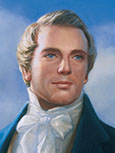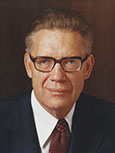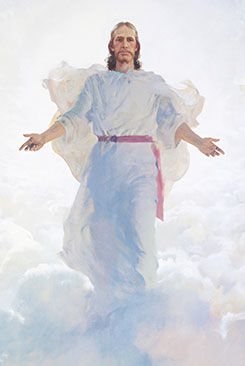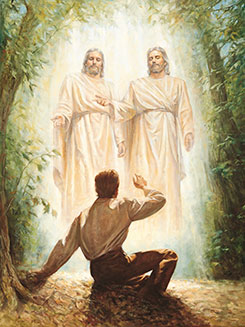Introduction
At the gate of the temple, Peter, accompanied by John, healed a man who had been born lame. Peter then taught the people who had witnessed the healing of this man. He testified of Jesus Christ, invited them to repent, and prophesied of the latter-day Restoration of the gospel.
Suggestions for Teaching
Acts 3:1–11
Peter and John heal a man who was born lame
Invite students to think of a time when they asked for something specific (perhaps a birthday or Christmas gift) but received something else instead. Ask a few of them to share their experiences and to explain how they felt when they did not receive what they wanted.
- • How might we compare these experiences to seeking blessings from Heavenly Father through prayer? (Sometimes Heavenly Father does not answer our prayers in the ways we expect or provide the blessings we ask for.)
Ask students to ponder experiences in which they did not receive the answer or blessing from Heavenly Father that they were expecting.
Invite the class to look for a principle as they study Acts 3 that will help them when they are not receiving the answers or blessings that they expect from the Lord.
Invite a student to read Acts 3:1–3 aloud. Ask the class to follow along, looking for whom Peter and John met at the gate of the temple.
- • Whom did Peter and John meet at the gate of the temple?
- • What does it mean that this man “asked an alms”? (verse 3). (You may want to explain that alms are items people donate to the poor.)
Point out that we learn from Acts 4:22 that the lame man was more than 40 years old.
- • Considering that this man had been unable to walk in 40 years, what condition may the lame man’s legs have been in?
Invite the class to consider how it would feel to be in the lame man’s position.
- • What are some typical ways in which people might respond to someone in this man’s situation?
Invite a student to read Acts 3:4–7 aloud. Ask the class to follow along, looking for what Peter did for this man.
- • What did Peter do for this man?
- • What stands out to you about Peter’s actions and words?
Invite a student to read Acts 3:8 aloud, and ask the class to look for what the man did after Peter “lifted him up” (verse 7).
- • What did the man do after Peter “lifted him up”?
- • In what ways was the blessing this man received greater than the alms he had originally asked for?
Encourage students to recall the experience in which they received an answer or blessing from Heavenly Father that was different from the answer or blessing they had been expecting.
- • What truth can we learn from Acts 3:1–8 that can help us when we do not receive the answer or blessing we are expecting from Heavenly Father? (Students may use different words but should identify the following truth: Heavenly Father might not answer our prayers in the ways we want or expect Him to, but His answers are always for our greater good. Write this truth on the board, and consider inviting students to write it in the margin of their scriptures next to verse 6.)
- • How might Heavenly Father answer our prayers differently than how we want or expect Him to? (For example, He might give us strength to endure a trial rather than removing it, or He might give us wisdom to help us solve a problem rather than solving it for us.)
Explain that in the account recorded in Acts 3:1–8, it is obvious that what this man received was greater than what he had asked for. However, in other cases it may not be as clear that what we are receiving is greater than what we asked for.
- • How can remembering the truth written on the board help us when we receive an answer to prayer that differs from the answer we expected?
Invite students to ponder experiences in which the Lord’s response to their prayers was different from the answer they desired but turned out to be for their greater good. Ask a few students to share their experiences. You may also want to share an experience of your own.
Invite a student to read Acts 3:9–11 aloud. Ask the class to follow along, looking for how the people reacted to this man’s healing.
- • How did the people react to this man’s healing?
Acts 3:12–26
Peter testifies of Jesus Christ and preaches repentance
Invite the class to imagine that they had been among the people at the temple who witnessed the healing of the lame man. Point out that these people had often seen the lame man begging as they entered the temple gates, but after he had been healed, they saw him leaping and walking.
- • If you had been among the people at the temple, how do you think your view of Peter and John might have changed after witnessing this miracle?
Divide students into pairs. Invite each pair to read Acts 3:12–16 aloud together, looking for how Peter explained the healing of the lame man to the crowd. After sufficient time, ask:
- • Did Peter take personal credit for healing the man?
- • By what power did Peter say the man had been healed? (After students respond, write the following truth on the board: Jesus Christ’s servants can perform miracles through faith in His name.)
Explain that Peter used this occasion to teach the people about Jesus Christ, who had recently been condemned to death by His own people but had overcome death through His Resurrection.
Invite a student to read Acts 3:17–21 aloud, including the Joseph Smith Translation changes for verses 17 (see footnote a) and 20 (see footnote b). Ask the class to follow along, looking for Peter’s invitation to the people.
- • What did Peter invite the people to do?
To help students understand Peter’s message, point out that Peter was speaking to the people who had called for or consented to the Crucifixion of Jesus Christ (see Acts 3:14–15). Invite a student to read aloud the following statement by the Prophet Joseph Smith:

“[Peter] did not say to them, ‘Repent and be baptized, for the remission of your sins;’ but he said, ‘Repent ye therefore, and be converted, that your sins may be blotted out, when the times of refreshing shall come from the presence of the Lord.’ [Acts 3:19.]
“… They could not be baptized for the remission of sins for they had shed innocent blood” (in History of the Church, 6:253).
Point out the phrase “when the times of refreshing shall come from the presence of the Lord; and he shall send Jesus Christ” (verses 19–20).
- • What do you think this phrase refers to?
Invite a student to read aloud the following statement by Elder Bruce R. McConkie of the Quorum of the Twelve Apostles:

“This designated period, this times of refreshing, is to take place at the second coming of the Son of Man, in the day when the Lord sends Christ again to earth.
“… It is the day when ‘the earth will be renewed and receive its paradisiacal glory.’ (Tenth Article of Faith.) It is the day of the ‘new earth’ that Isaiah saw (Isa. 65:17), the earth which will prevail when wickedness ceases, when the millennial era is ushered in” (in Conference Report, Oct. 1967, 43).

On the board, display the picture The Second Coming (Gospel Art Book [2009], no. 66; see also LDS.org). Label it by writing The times of refreshing on the board near the picture.
- • How will the earth be refreshed at Jesus Christ’s Second Coming? (It will be cleansed of wickedness.)
Point out the phrase “times of restitution of all things” (verse 21).
- • What do you think the “times of restitution of all things” refers to? (You may want to point out Acts 3:21, footnote a to help students understand that this refers to the Restoration of the gospel in the latter days. Jesus Christ would remain in heaven during the coming period of apostasy, but He would return to the earth to bring about the restitution or restoration of all things pertaining to the gospel. You may also want to point out that Peter used the phrase “times of restitution of all things” to describe instances when Jesus Christ would visit the earth before His Second Coming.)
- • When has Jesus Christ visited the earth as part of the latter-day Restoration of the gospel? (Students might mention the Savior’s appearances in Joseph Smith’s First Vision [see Joseph Smith—History 1:17] and at the Kirtland Temple [see D&C 110:2–5].)

On the board, display the picture The First Vision (Gospel Art Book, no. 90; see also LDS.org). Label it by writing The times of restitution of all things on the board near the picture.
- • According to verse 21, who in addition to Peter had spoken of the latter-day Restoration of the gospel? (Using their own words, students should identify the following doctrine: Prophets in all ages have foretold the latter-day Restoration of the gospel.)
Summarize Acts 3:22–26 by explaining that Peter testified that Moses “and all the prophets from Samuel and those that follow after” (verse 24) had spoken of Jesus Christ and warned of the consequences of rejecting Him (verse 23).
You may want to conclude by sharing your testimony that Jesus Christ has come to earth as part of the latter-day Restoration of the gospel and that He will return at His Second Coming to cleanse the earth of wickedness.
 Scripture Mastery—Acts 3:19–21
Scripture Mastery—Acts 3:19–21
To help students understand how to use Acts 3:19–21 in a missionary setting, present the following scenario: An investigator asks, “Where in the Bible does it say that the gospel would be restored in the last days?”
Divide students into pairs. Ask each pair to prepare an answer to this question using Acts 3:19–21 and at least one other Bible passage. You might encourage them to look under “Restoration of the Gospel” in the Topical Guide.
After sufficient time, invite a student to role-play as the investigator and one of the pairs of students to role-play as missionaries in front of the class. Ask the pair of students role-playing as missionaries to share their prepared answer with the student who is role-playing as the investigator.
Commentary and Background Information
Acts 3:6. “Such as I have give I thee”
While serving as the dean of religious instruction at Brigham Young University, Elder Jeffrey R. Holland of the Quorum of the Twelve Apostles explained:
“Peter had no money but he had riches: ‘such as he had’ included every key to the kingdom of God on earth, priesthood power to raise the dead, faith to strengthen bones and sinews, a strong right hand of Christian fellowship. He could not give silver or gold but he could give that which is always purchased ‘without money and without price’ (Isa. 55:1)—and he gave it” (“The Lengthening Shadow of Peter,” Ensign, Sept. 1975, 30).
Acts 3:7. “And he took him by the right hand, and lifted him up”
Elder Bruce R. McConkie of the Quorum of the Twelve Apostles explained that the account of Peter healing the lame man illustrates the truth that priesthood holders act in the stead of Jesus Christ when they give blessings:
“Peter did not ask the Lord to heal the cripple; he did not pray to God to pour out his grace and healing virtue upon the lame man. Instead—acting in the Lord’s name and by virtue of a delegation of priestly authority already received—he himself commanded the miracle to occur. Peter was the Lord’s servant, his representative and agent; he stood in the place and stead of Christ, doing what the Master would have done if personally present” (Doctrinal New Testament Commentary, 3 vols. [1965–73], 2:46).
This truth is also illustrated in Doctrine and Covenants 36:2, in which the Lord stated, “I will lay my hand upon you [Edward Partridge] by the hand of my servant Sidney Rigdon.”
President Harold B. Lee taught another important truth, using the example of Peter’s behavior after Peter had healed the lame man by the power of the priesthood:
“Will you see that picture now of that noble soul, that chiefest of the apostles, perhaps with his arms around the shoulders of this man, and saying, ‘Now, my good man, have courage, I will take a few steps with you. Let’s walk together, and I assure you that you can walk, because you have received a blessing by the power and authority that God has given unto us as men, his servants.’ Then the man leaped with joy.
“You cannot lift another soul until you are standing on higher ground than he is. You must be sure, if you would rescue the man, that you yourself are setting the example of what you would have him be. You cannot light a fire in another soul unless it is burning in your own soul” (“Stand Ye in Holy Places,” Ensign,July 1973, 123).
Supplemental Teaching Idea
Acts 3:22–23. “Every soul, which will not hear that prophet [Jesus Christ]”
Invite a student to read Acts 3:22–23 aloud. Ask the class to follow along, looking for what Moses prophesied about Jesus Christ.
- • What did Moses prophesy about Jesus Christ?
- • In what ways was Moses like Jesus Christ? (Moses’s ministry foreshadowed Jesus’s ministry. Both of them performed miracles and delivered God’s word to His people, though the magnitude and importance of Jesus Christ’s ministry and mission far exceeded that of Moses or any other prophet.)
- • According to these verses, what did Moses say will happen to people who do not “hear [the words of Jesus Christ] in all things”? (verse 22). (After students respond, write the following principle on the board: If we do not hear the words of Jesus Christ in all things, then we will be destroyed from among the people.)
- • What does it mean to “be destroyed from among the people”? (verse 23). (You may need to explain that this refers to spiritual death, or separation from the Lord and His people.)
- • What does it mean to “hear [the words of Jesus Christ] in all things”? (verse 22). (Help students understand that to hearmeans to listen to and follow. We cannot be saved without following the Savior.)
Testify of the importance of listening to and following the words of Jesus Christ.

沒有留言:
張貼留言